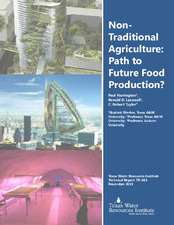| dc.description.abstract | The world population is growing rapidly, and the amount of arable land is decreasing. This raises the issue of how to feed the 2050 projected population of nine billion people. Another issue is the presence of “food deserts.” Food deserts are defined as urban neighborhoods and rural towns without ready access to fresh, healthy, and affordable food.
The purpose of this report is to examine possible alternatives for food production that are also located in close proximity to demand. Included in non-traditional production agriculture are several concepts currently in use, including greenhouses (covered agriculture), backyard gardens (called Victory Gardens during WW II), agriculture-designated land within urban areas, underground facilities (bomb shelters), urban agriculture in housing developments, and converted warehouses. Other production concepts are presented to demonstrate the breadth of discussion regarding meeting future food demand.
In the several cases of unique, non-traditional agriculture, each is a new industry with few players in the market, suggesting time will be the final decision-maker on viability (agronomic and economic). Greenhouses have been a part of production agriculture for centuries, with the technology well-defined. But retrofitting abandoned warehouses or constructing high rise facilities, as well as production in high rise housing units, will take time to perfect the systems involved, including a water and reuse system, fertilization, pest and disease control, harvesting, overall quality control, and logistics.
The necessary components of non-traditional food production facilities are resources, land, water, equipment and finances. Highly fertile land has for the most part been allocated to crop cultivation, and the quantity of high-quality water for irrigation is declining. Non-traditional systems typically have a much smaller land footprint and are highly efficient in water use. The implication is that non-traditional food production systems will provide society with more quantity, plus improved quality, of high-value food products per unit of land and per unit of water.
This is a broad, brief review of actual production facilities, as well as projections for the future. Included are greenhouses, retrofitted warehouses, below-surface facilities, high rise facilities, and production near cities. This piece is intended to provide insight into the broad range of non-traditional food production facilities emerging and envisioned at this time. The mention of any business is not to be interpreted as endorsement or suggestion that it is viable. | en |


